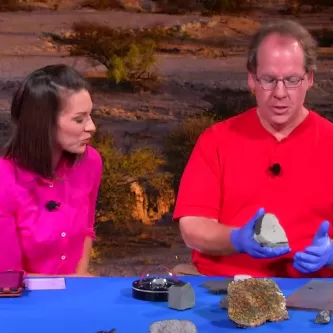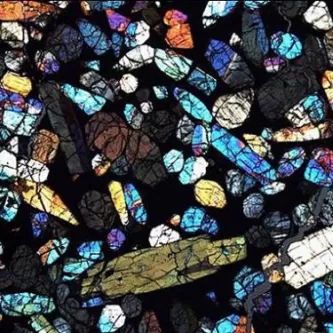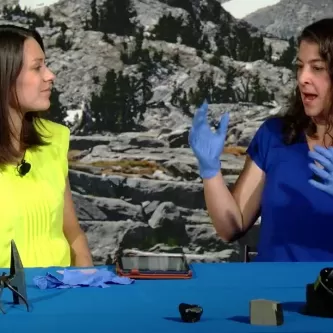Search
Meteorites: Messengers From Outer Space
Big Bang Over Russia
At dawn on February 13, 2013, a meteor blazed an arc through the sky near Chelyabinsk, Russia. Unlike most shooting stars, however, this one did not quickly flare out. Instead it became bigger and brighter, then exploded about 23.2 kilometers (14.5 miles) above the ground in a fireball more brilliant than the sun. Sound waves from the blast shook the region, breaking windows in thousands of buildings across six cities. Hours after impact, online videos of the event had received millions of views.
This meteor was a large space rock, about 17 meters (56 feet) across. When it exploded in the atmosphere, small pieces of it fell to the ground. These are known as pieces of the Chelyabinsk meteorite; more than 200 have been found.
Meteorites aren’t just fascinating space rocks that fall from the sky; researchers around the world, and at the Smithsonian’s National Museum of Natural history, study them to better understand the formation and evolution of our solar system.
What Are Meteorites?
Tens of thousands of meteorites enter our planet's atmosphere each day, but most are the size of a grain of rice or smaller. Meteorites are precious rock samples preserving material from the birth of the Solar System 4.6 billion years ago. Some are actual pieces of the original matter from which the planets were assembled. Others are fragments of asteroids that grew hot enough to develop crusts, mantles, and cores. When these extraterrestrial rocks land on Earth, they provide an extraordinary opportunity to piece together the history of our Solar System's birth and evolution.
The Three Ms: Meteroid, Meteor, Meteorite
- A meteoroid is a natural fragment of rock less than 1 km (.6 mi) across that orbits the Sun.
- A meteor is the streak of light caused when a meteoroid enters Earth's atmosphere. Air friction melts the meteoroid's surface, making it glow white hot. Meteors also are called shooting stars.
- A meteorite is a meteoroid that survives the fiery passage through the atmosphere and crashes to Earth.
Like rocks, meteorites are made up of minerals. Some of the minerals are the same ones seen in Earth rocks, but others are not found on Earth at all. In both cases, the minerals provide clues to the meteorites’ origins. There are three main types of meteorites: stony (the most common), stony-iron, and iron.
Where Do Meteorites Come From?
Most meteorites come from the asteroid belt, a collection of small rocky bodies – they're about 1,000 km (600 miles) or less in diameter – orbiting the Sun between the paths of Mars and Jupiter. The first clear meteorite evidence came in 1959, when scientists were able to photograph an incoming meteorite with enough accuracy to calculate its orbit and determine where it originated. Since then, many other meteorites have been traced back to the asteroid belt as well. In the 1980s, scientists recognized that a few rare meteorites come from the Moon and Mars. Comets are probably a significant source of the dust-like micrometeorites that shower the Earth each day.
Fewer meteorites come from Mars and our Moon, blasted off their surface when meteorites crashed into their surfaces and blew pieces into space. Scientists are able to identify where they came because we have samples of Moon rocks from the Apollo missions and we have been able to analyze Mars’ atmosphere remotely from space. Tiny samples of Mars’ atmosphere are preserved in microscopic bubbles in the Martian meteorites.
Where Can You Find Meteorites?
Meteorites fall everywhere on Earth. Most plunge into the oceans that cover three-quarters of the surface and are lost. Even those that fall on land can be difficult to recognize unless you see them hit the ground.
The best places to look for meteorites have little or no vegetation to camouflage them and few Earth rocks. That's why glaciers, deserts, and rock-free plains are prime meteorite hunting grounds.
More meteorites have been discovered in Antarctica than anywhere else on Earth. Not only are meteorites relatively easy to recognize against the ice, but the moving glacial ice actually concentrates the rocks in certain areas. As a bonus, the Antarctic deep freeze helps protect meteorites from the effects of weathering for thousands of years.
The United States' Antarctic Meteorite Program is a cooperative agreement between three agencies – the National Science Foundation, NASA, and the Smithsonian Institution – providing for the collection, curation, distribution, and long-term storage of meteorites recovered during annual U.S. expeditions to Antarctica. This program continues to be an inexpensive yet guaranteed way to recover meteorites from the Moon, Mars, and previously unsampled asteroids.
The Smithsonian provides initial characterizations of newly collected Antarctic specimens and, ultimately, permanent storage and distribution to the scientific community. These meteorites are housed at the Museum Support Center clean room facility at Suitland, Md. Nearly 16,000 Antarctic meteorites have been collected since 1976, and over 14,000 of them have been permanently transferred to the Smithsonian.
National Meteorite Collection
The Smithsonian National Museum of Natural History houses the National Meteorite Collection, which includes more than 55,000 specimens of more than 20,000 distinct meteorites. (Learn more about the Museum's collections.)
Julie Hoskin is the Meteorite Collections Manager at the Museum. She distributes meteorite samples to scientists around the world and tracks all the scientific advances that result from the Smithsonian's collection.
One of the collection's most famous meteorites is the Allende meteorite, the result of a meteoroid exploding into thousands of pieces near a town of that name in Mexico in 1969. Five days after the fall, Smithsonian scientists were on the ground gathering samples, including one enormous stone weighing 242 pounds (110 kg).
The Allende meteorite is a rare type of stony meteorite, a Type III carbonaceous chondrite. It turned out to contain curious small white objects, which didn’t look like anything anyone had studied before. They are called calcium-aluminum inclusions, or CAIs, some of the oldest matter known in our planetary system – minerals that have much the same composition as the sun (minus the hydrogen and helium). Allende is in essence pre-planetary material from the solar nebula, the cloud of gas and dust from which the Sun, planets, asteroids and comets eventually formed. In studying Allende, scientists can read the history of the beginning of the solar system. And with it, for the first time, scientists had found a key to unlocking the first half billion years of Earth’s history.
With the Allende fall, the study of meteorites became an integral part of earth science. It was in fact a catalyst for the birth of a new science: cosmo-chemistry, a discipline at the intersection of geology, planetary science, astronomy, and astrophysics.
Meteorite Research
The Museum has a team of scientists studying these extraterrestrial rocks. Meteorites Curator Dr. Glenn MacPherson investigates particles in chondritic meteorites, searching for clues to the range of chemical and physical processing and timing of events in the solar nebula.
MacPherson has participated in the analyses of cometary dust collected by NASA’s Stardust Mission. These particles provide our first returned samples of a comet and the first samples that can be related to a known comet. Their study is revealing fascinating clues to the early evolution of our Solar System.
Dr. Timothy McCoy is Curator-in-Charge of the Meteorite Collection. He investigates a wide range of processes that occurred during the melting of asteroids, using both the mineralogy and texture of meteorites and the reflectance spectra (how light of varying wavelengths is reflected by an object) of asteroids to understand how asteroids composed of primitive meteorites changed to become layered worlds with cores, mantles, and crusts like the Earth.
Geologist Dr. Catherine Corrigan is the Curator of Antarctic Meteorites at the Museum. She studies a number of different types of meteorites, including those from the Moon and Mars, and is involved in the Mars Exploration Rover project, processing images that come down from the Opportunity Rover. She has been to Antarctica twice to collect meteorites.



